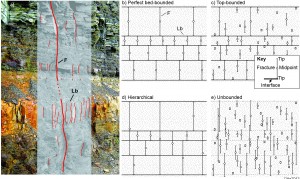Shale – Mudrock Fracture Research
Production of hydrocarbons from shale and other fine-grained source rocks has developed rapidly over the last decade. While technological breakthroughs in well completions led the initial expansion, recognition that natural fractures are important in these reservoirs has increased. Natural fractures can enhance permeability and may interact with hydraulic fractures during stimulation.
Dr. Julia F. W. Gale leads shale structure research within The University of Texas. Gale manages the Fracture Research and Application Consortium and leads the Structural Diagenesis Initiative effort in shale natural fracture research. The first phase of the research has been to establish the broad characteristics of fractures in shales; this work culminated in a major review paper, Gale et al., 2014.
The next phase, currently underway, is to examine shale fracture and host rock attributes more closely. In addition to collection of data in core and outcrop on fracture size–width, length, height—and on spacing and openness attributes, the group is now using fluid inclusions and stable isotope geochemistry to establish conditions and timing of fracture formation and exploring the nature of fluids from which fracture cements precipitate. Using the burial history for the samples and temperature information from fracture cements allows us to establish fracture timing, which in turn leads to better understanding of fracture mechanisms.
Gale works closely with Jon Olson on how attributes of natural fractures may interact with hydraulic fractures.
Gale also collaborates on projects examining the potential link between seismicity and fluid production/injection in basins with high unconventional reservoir activity.
Gale continues to be involved in fundamental research on fracture size scaling and spatial arrangement.
Gale was an AAPG Distinguished Lecturer in 2013-2014. She serves as an Associate Editor for AAPG Bulletin. Her 2010 paper Modeling fracture porosity evolution in dolostone published in the Journal of Structural Geology was awarded the 2011 Publication Award, in recognition of exemplary publication of scientific or economic impact, from the Bureau of Economic Geology, The University of Texas.
The following papers reflect some of Gale’s current research interests:
- Natural fractures in shale: A review and new observations. Gale, J. F. W., Laubach, S. E., Olson, J. E., Eichhubl, P., and Fall, A., 2014, AAPG Bulletin, Special Issue on Faulting and Fracturing in Shale and Self-Sourced Reservoirs. 98/11, 2165-2216. doi: 10.1306/08121413151 | view
- Natural sealed fractures in mudrocks: A case study tied to burial history from the Barnett Shale, Fort Worth Basin, Texas, USA. Gasparrini M., Sassi W., and Gale J. F.W. 2014, Marine and Petroleum Geology 55, 122-141.
- Natural fractures in some U.S. shales and their importance for gas production. Gale, J. F. W., and Holder, J., 2010,The Geological Society, London, Petroleum Geology Conference Series 7, 1131‒1140. doi: 10.1144/0070899
- Modeling fracture porosity evolution in dolostone. Gale, J. F., Lander, R. H., Reed, R. M., and Laubach, S. E., 2010, Journal of Structural Geology 32/9, 1201-1211. doi:10.1016/j.jsg.2009.04.018.
- Natural fractures in the Barnett Shale and their importance for hydraulic fracture treatments. Gale, J. F. W., Reed, R. M., and Holder, J., 2007, AAPG Bulletin 91/4, 603–622.
- Specifying lengths of horizontal wells in fractured reservoirs. Gale, J. F. W., 2002, Society of Petroleum Engineers Reservoir Evaluation and Engineering 5/3, 266–272.
Shale Fracture Research Program
Natural fractures in shale hydrocarbon reservoirs are common and typically occur as one or more of the following; those at high angle to bedding, faults, bed-parallel fractures, early compacted fractures and fractures associated with concretions. These fractures differ markedly in their prevalence and arrangement within each shale play, however, constituting different fracture stratigraphies—differences that depend on interface and mechanical properties governed by depositional, diagenetic, and structural setting. Several mechanisms may act independently or in combination to cause fracture growth, including differential compaction, local and regional stress changes associated with tectonic events, strain accommodation around large structures, catagenesis, and uplift.

Height classification after Hooker et al. 2013; from Gale et al. 2014, Natural fractures in shale: A review and new observations
Natural fractures in shales likely grew by slow, chemically assisted (subcritical) propagation and we use a subcritical propagation criterion to model the growing fractures. The subcritical crack index (SCI) is a mechanical rock property that controls fracture spacing and an input parameter for the models. Measurements of shale SCI values shows variability, and translates to different modeled spatial arrangement; high values >100 suggesting clustering, more moderate values ~50-80 suggest more even spacing. We are testing the modeled patterns with spatial organization analysis of fractures interpreted in horizontal image logs.
Natural fractures may interact with hydraulic-fracture stimulation. Factors governing the interaction include natural fracture intensity, orientation with respect to reservoir stress directions, and the strength of the fracture plane relative to intact host rock. We tested the effect of calcite-sealed fractures in Barnett Shale on tensile strength of shale with a bending test. Samples containing natural fractures have half the tensile strength of those without and always break along the natural fracture plane. Yet in other examples the weakness is in the cement itself, partly because of retained fracture porosity. The role of microfractures in production from shale is currently poorly understood yet potentially critical; we identify a need for further work in this field and on the role of natural fractures generally.
As noted in the Gale et al. 2014 review paper, progress in understanding fracture systems in shale/mudrock systems has come from viewing the problems from the structural diagenesis perspective.
Contact Gale for more information on worldwide shale/mudrock fracture research within the Initiative.
Information about the SEM CL Facility



